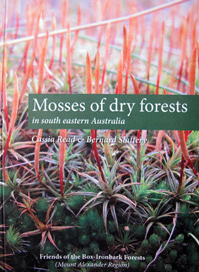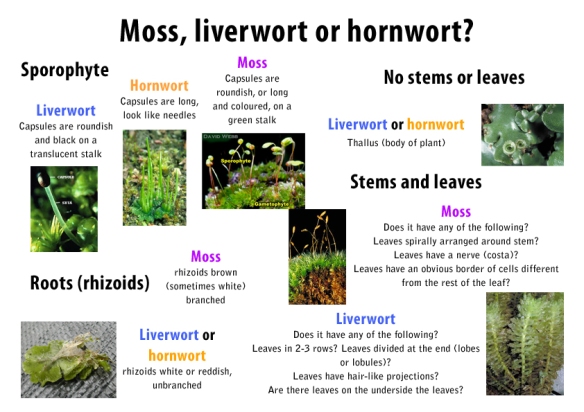At the end of my 3rd year BSc. I had no idea that I would be launched into the world of mosses, liverworts and hornworts for my Honours year. I began a project looking at Ecological Vegetation Classes and their ability to be surrogates for other components of biodiversity, i.e. bryophytes. The journey began, and I was hooked. If you are interested in knowing what that green stuff growing in the pavement cracks is, or curious about the green carpet of cool temperate rainforest, then don’t be scared to find out more. Bryology isn’t as hard as it looks. Consider them as vascular plants at a much smaller scale.
‘Is this a moss, or a liverwort? Or maybe it’s a hornwort?’
These were the words the late Dr George A.M. Scott asked me, after placing what looked like a tiny scrap of green something-or-other on the viewing plate of a dissecting microscope. ‘Liverwort’ I answered. Woohoo! I was right! George named me a ‘budding protonema’ and I am sure he also gave others this name.
If you are used to identifying vascular plants, then you should be used to noting lichens and bryophytes. However, you may/may not be used to separating bryophytes into moss, liverwort and hornwort. So assuming some botanical knowledge follow the diagrams below as a rough guide. For starters, moss and liverwort reproductive structures (sporophytes) are easy to differentiate. But more often than not, these are not present. So look at the stems and leaves, or the absence of them, and look at the roots (rhizoids). You should be able to differentiate your green stuff into moss, liverwort or hornwort using this simple sheet.
Now that you have more confidence, you can leap forward to working out what your moss/liverwort/hornwort is classified as. I can recommend purchasing Read and Slattery (2014) or Meagher and Fuhrer (2003) for some direction. Although the titles indicate they are moss field guides, and Australian based, they will give you the basics for learning how to identify bryophytes anywhere in the world and Meagher and Fuhrer does include liverworts and hornworts (the ‘allied plants’ in the book title). For something more specific, Jarman and Fuhrer (1995) is great for Tasmanian rainforest.
Read and Slattery is a handy fit-in-your-back-pocket-size and suitable for the drier Australian forests. The photography displays details well and the list of extra species in the back of the book will direct you to further information. They give you some ideas on shape and function to help decipher your bryophyte and even give you a brief explanation of ‘what’s in a name’ as bryophytes don’t have common names (well they are not commonly used or accepted in Australia). The book is devoid of technical language, but still manages to help you decipher your specimen.
Meagher and Fuhrer (2003) is well worth purchasing, but may be hard to get (but I am sure a new edition will be produced!). Meagher has included a key in the book where you can take your moss/liverwort/hornwort and place it in a group based on some feature or other. The good news is the keys don’t rely on reproductive structures (sporophytes), so getting to a species, genus or family is quite assured. Fuhrer’s images are something to be jealous of. There is only one image is per species, however, each image shows distinctive characteristics which will help with your identifications. Meagher and Fuhrer follow a standard form of describing the species based on leaves, nerves etc., but they do deter from this where necessary e.g. Fissidens spp. The similar species comments at the end of each description are very helpful. Not everyone owns a Glossarium Polyglottum Bryologiae (this version on line is also very useful just make sure you click ‘bryophyte’ glossary) so Meagher and Fuhrer’s list is a good starting point. For the locals, Meagher and Fuhrer indicate in what Australian state each species is found; a very useful piece of information and one that will assist with future conservation.
The beginning of Australian bryophyte field guides would have to have be Jarman and Fuhrer (1995), with thanks to the authors, CSIRO and Forestry Tasmania (Forestry Tasmania has been the backbone for much bryological research in Tasmania). The book is cool temperate rainforest focused, so there are fewer descriptions of species than Meagher and Fuhrer (2003). The brief species descriptions are complemented by detailed photographs, so the strength of this book is when it is used in conjunction with Meagher and Fuhrer (2003) as the fine detailed photography of structures such as gemmae and air pores in Jarman and Fuhrer (1995) are second to none.
Alas these books only cover the southern part of Australia. What about the drier areas and the tropics? Bryophytes have been collected from these areas – the collections by Ilma Stone in particular are of great value. Scott, Stone and Rosser (1976, see list below) lists tropical Australian mosses. This webpage on the History of research on Australian Mosses by bryologist Helen Ramsay is a great read and will give you leads on what further reading is available (by state). Also found on the webpage is this paper by Ramsay and Cairns (2004) which is a good starting point. Note the webpage was written in 2006 and since then a simple Google search will show you there have been additions to tropical bryology (e.g. by Andi Cairns, David Meagher and David Tng). David Tng’s blog about a trip with Andi and David ‘Tropical Moss Mania in Far North Queensland’ is a wonderful read. As to bryophytes in arid areas, a search on Prof. David Eldridge will turn up a plethora of work on cryptogamic crusts that is both fascinating and humbling.
To get past the initial stage of moss or liverwort, I relied on a couple of technical books. Some are still relevant today (see descriptions below) but most are out of print and very expensive to buy (hold onto them if you find or have them!). These days the internet is a great source of information for bryology. The Australian National Botanical Gardens Bryophyte Portal is my first port-of-call for taxonomic information. Here you can read all about bryophytes: ecology, habitat, bryogeography etc. If you want more specific information then there is an online Australian Mosses page and a checklist of Australian Liverworts and Hornworts and Catalogue of Australian Mosses. There is an online key you can peruse at the University of Tasmania School of Biological Sciences. Don’t be put off by the ‘Vascular plant’ title – scroll down and you will see liverworts and mosses are covered. And if you want to search records or plot maps don’t forget the Australian Virtual Herbarium and Atlas of Living Australia which includes specialist collections such as the University Of Melbourne Herbarium (MELU) which I had access to in my Hons year (when it housed the bryophyte collections of the late George A.M. Scott and Ilma G. Stone). Not all Australian Herbaria have uploaded their bryophyte records to these databases e.g. HO [Hobart]) but I expect it is only a matter of time before all records are databased online. Lastly, there is a bryological network in Australia and they produce the Australasian Bryological Newsletter. It’s been published for a while now (it’s only 5 years younger than me!) and the issues are well worth reading.
Australians – don’t forget to look next door to New Zealand! We do share some similarities and the New Zealand bryological community is thriving. Much of their flora is available online. There is much similarity between Southern Australia and our over-the-Tasman friends have produced some fantastic resources. The Index of NZ Flora and the NZ flora publications on moss families (pdf files) are great resources (thanks must go to Dr Pat Brownsey for providing these links).
These are just a few tools which will help get you started in the non-vascular plant world. I can assure you, once you identify a few specimens, you will be hooked. The thrill and wonder of these small, ecologically important, ancient and intricately detailed plants is something you will never overlook again.
Happy bryophyte hunting!
Some technical resources
Note that being out of print, these will only be found in second hand bookshops, and may be worth a lot!
Back in 1996 this book was a great starting point for mosses. Much is now superseded by taxonomic accounts, but many of the descriptions are still relevant and the illustrations are superb. I will forever be in debt to my then co-supervisor Lucille Turner for finding my copy in a Carlton bookshop for $20AUD. Now it fetches between $150 and $600 AUD, so if you find a copy HANG ON TO IT!
- Scott, George .A.M. (1985). Southern Australian Liverworts. Australia Flora and Fauna No 2. Bureau of Flora and Fauna, Canberra.
I picked a copy of this up from the Government Bookshop in Melbourne for the princely sum of $12.50AUD (it was 50% off RRP). I wish I bought more copies. As for the above moss book, the descriptions are more or less still current and the illustrations are still very useful.
- Catcheside, David. G. (1980). Mosses of South Australia (Handbook of the flora and fauna of South Australia). Adelaide, South Australia. Govt. Printer. Handbooks of the flora and fauna of South Australia. 364 pp.
This book I used in conjunction with George’s book and they complemented each other well.
I also used texts from New Zealand (note they are also out of print) such as
- Beever Jessica., Allison K. W. & Child J. (1992) The mosses of New Zealand. University of Otago Press, Dunedin.
- Allison K. W. & Child J. (1975) The liverworts of New Zealand. University of Otago Press, Dunedin. References and image creditsJarman, S.J. & Fuhrer, B. (1995) Mosses and Liverworts of Rainforest in Tasmania and South-eastern Australia. CSIRO Publishing and Forestry Tasmania. Collingwood. ISBN: 0643056858. Paperback.Meagher, D. & Fuhrer, B. (2003) A Field Guide to the Mosses and Allied Plants of Southern Australia. CSIRO Publishing. Collingwood. Price ~$52.95 USD. ISBN: 978-0642568281. Paperback.Read, C. & Slattery, B. (2014) Mosses of dry forests in south eastern Australia. Friends of the Box-Ironbark Forests (Mount Alexander Region). Castlemaine. 101 pp. Price $15.00 AUD. ISBN: 978-0-646-91693-4. Paperback.Ramsay, HP & Cairns, A. (2004). Habitat, distribution and the phytogeographical affinities of mosses in the Wet Tropics bioregion, north-east Queensland, Australia. Cunninghamiana, 8, 371-408.
Moss sporophytehttp://41.media.tumblr.com/tumblr_lhnindEqM51qhgupao1_500.jpg
Liverwort sporophyte
http://www.bio.umass.edu/biology/conn.river/plant_images/sporo.jpg
Hornwort sporophyte
http://www.cpbr.gov.au/bryophyte/photos-800/anthoceros-101.jpg
Thallus
http://www.cpbr.gov.au/bryophyte/photos-captions/marchantia-sp-34.html
Leafy liverwort
http://www.cpbr.gov.au/bryophyte/photos-300/schisto-balfouriana-28.jpg
Liverwort rhizoids
http://oregonstate.edu/dept/nursery-weeds/weedspeciespage/liverwort/rhizoids_4_750.jpg
Moss stems, leaves and rhizoids
http://www.cpbr.gov.au/bryophyte/photos-300/lepto-macrocarpon-72.jpg




Thank you for inspiring a ‘beginner’ in this field on a way to educate herself.
LikeLiked by 1 person
Thanks Lauree Brown. I hope you find the bryological world as fascinating as I do.
LikeLike
Thank you for your great article. I hope to print it and store it in a convenient place so that I know what I am finding. We have such lovely specimens where we, Helen Robertson and I forage
LikeLiked by 1 person
Thanks Pat Harrison. I’m glad you liked it and have opted to store it for future use. I enjoy seeing the images you and Helen post and the places you visit . A picture does have 1000 words. Please keep up the great work.
LikeLike